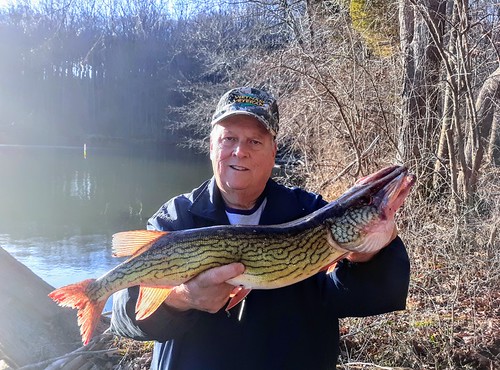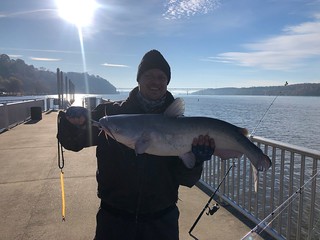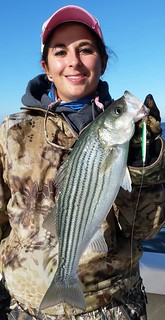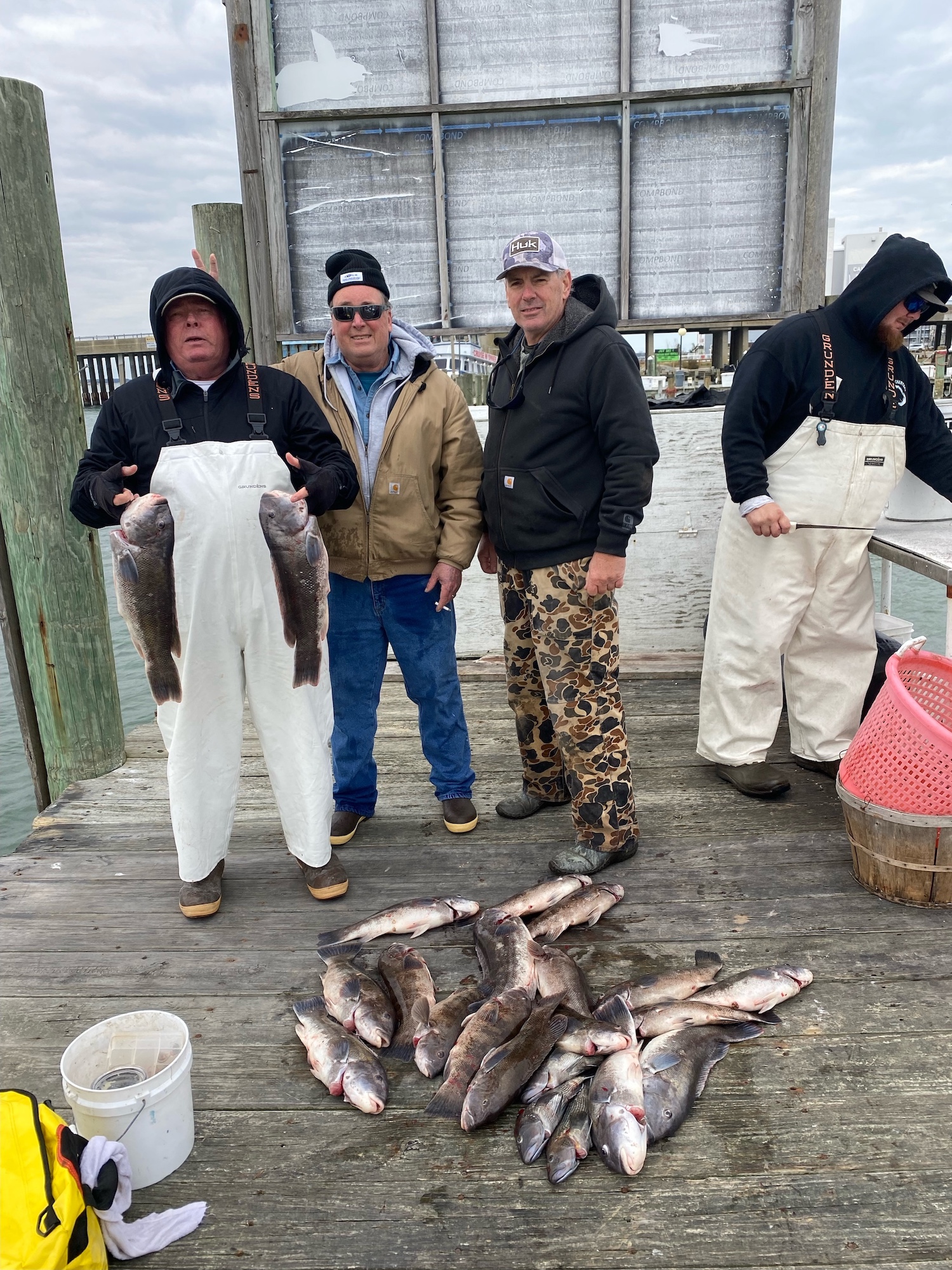Maryland Fishing Report – December 1

Gary Budny holds up a beautiful chain pickerel he caught and released at Loch Raven Reservoir. Photo courtesy of Gary Budny
Everywhere in Maryland, colder weather is setting in as we enter December. Some species of fish will begin to hunker down for the winter months while others relish the colder water temperatures. Fishing for blue catfish, trout, and chain pickerel often excels during the winter months, and saltwater fishing for sea bass and tautog provide plenty of action along the coasts.
Forecast Summary: December 1 – December 7:
Expect sunny and cool weather all week with windy conditions on Thursday and Friday. Surface waters and Bay rivers continue to cool faster than the bottom waters. Bay surface water temperatures have dropped to the upper 40s. Baitfish have moved out of the rivers in search of the deeper, warmer waters with gamefish nearby. Anglers should focus on the warmer, deeper bottom waters such as river mouths, channel edges, underwater points, hard bottom, and drop-offs from the Bay Bridge south to the Virginia state line.
There is suitable oxygen to the bottom in all of Maryland’s Bay waters. Upper Bay waters down to Tilghman Island are running fresher than normal.
Expect normal flows for most Maryland rivers and streams. There will be above average tidal currents all week due to the upcoming new moon on Dec. 4.
Expect good water clarity for most of Maryland’s rivers and main Bay areas. The Bush and Back rivers may have poorer clarity from algal blooms. To see the latest water clarity conditions, check Eyes on the Bay Satellite Maps.
For more detailed and up-to-date fishing conditions in your area of the Bay, check the Maryland DNR website for Click Before You Cast. Get regular updates on Maryland’s waters sent to your inbox with our Eyes on the Bay newsletter. Sign up online.
Water temperatures in the lower Susquehanna River have dropped into the low 40s and with that the fishing for striped bass has slowed down considerably. The power generation releases at the Conowingo Dam have been fluctuating, sometimes cranking up in the early morning hours and other times shutting down. The best fishing for striped bass at the dam pool tends to be early in the morning for those casting a variety of lures. A high percentage of the fish being caught are sub-legal but some are above 19 inches.
The same situation is at the mouth of the river along the flats and channel areas. The early morning bite is best and the most fishing success is occurring along the channel edges in deeper water. Jigging is the most popular way to fish but some are having good success with deep-diving crankbaits.
The dominating presence of large blue catfish has impacted live lining with eels or drifting cut bait. This is an annoyance if you’re fishing for striped bass and lose your eel, but many anglers are now focusing on blue catfish and enjoying the action. Many of the blues being caught are large and can be caught on a variety of baits throughout the winter months. Blue catfish can be found in most of the tidal rivers in the upper Bay.
Trolling is a very popular way to target striped bass; umbrella rigs rigged with heavy inline weights are needed to get down deep where the striped bass are holding close to the bottom, and bucktails and swimshads are good choices for trailers. Use tandem-rigged swimshads behind inline weights or a planer if the drag is not too much to trip it. The mouths of the Magothy, Patapsco, and Chester rivers are good places to troll along channel edges.
Jigging is also a great way to fish for striped bass, working soft plastic jigs or metal jigs close to the bottom in the channel areas. The striped bass are holding deep now that water temperatures have dropped into the 40s this week. The fish are hugging the bottom seeking out slightly warmer waters. A further drop in water temperatures will see the smaller striped bass stop eating and most other activity, and the medium-sized fish will soon follow. Some of the best jigging options now are the Patapsco River channel near the Key Bridge, the Love Point Rocks, the Bay Bridge piers, and the sewer pipe near the bridge.
Anglers in the middle Bay are witnessing a steady slowdown in striped bass activity as water temperatures dip into the 40s. There is some scattered seagull activity over schools of bait with striped bass picking at them here and there. Most of the striped bass are holding close to the bottom in the deeper areas of the channels.
Trolling with heavy inline weights and umbrella rigs is a very popular way to target these deep-water fish; trailers are a mix of swimshads and bucktails. A single swimshad can also be pulled behind a planer and sometimes a tandem-rigged pair of swimshads or bucktails with a larger planer. Chartreuse and white tend to be the favored colors.
The shipping channel edge from the Gum Thickets south past Bloody Point to Buoy 83 and the Sharps Island Light has been an excellent place to look for striped bass recently. The western side of the shipping channel in front of Chesapeake Beach south to Parkers Creek has also been providing some action.
Jigging is a very good option for light tackle anglers and the deep channel edges are where most of the action is occurring. Most are jigging with large soft plastic jigs in white or chartreuse, but metal jigs are working well also. The fish are holding close to the bottom so jigs must reach the bottom.
There have been some white perch holding in 35 feet to 50 feet of water off Matapeake, and holding tight to oyster bottom in the lower Choptank River between Castle Haven Point and Horn Point. A bottom rig baited with pieces of bloodworm or a dropper rig with small flies or soft plastic jigs are the best ways to fish for them. The rock piles at the Bay Bridge often have large white perch holding deep in the current this time of the year. Those using dropper rigs have not come up with much except small striped bass, but hopefully that will change.
Anglers in the lower Bay are targeting striped bass by trolling and jigging. Those trolling are pulling umbrella rigs with heavy inline weights to get them down close to the bottom where the striped bass are holding. Those who are jigging are working the same deep channel edges.
Trolling along the deep channel edges is a very effective way to fish right now. Colder waters are causing many striped bass to move deep, looking for slightly warmer temperatures. The channel areas at the mouth of the Potomac River from Point Lookout to Smith Point are good to target. The western side of the shipping channel near Cove Point to Cedar Point and the eastern side of the channel from the HS Buoy south to the Middle Grounds have been good places to fish, whether trolling or jigging.
There is sporadic seagull activity being reported with striped bass pushing schools of bait to the surface. There are still some juvenile menhaden making their way through the region. The fish on top tend to be smaller striped bass, but larger ones often lurk deeper underneath the surface action.
Anglers who are light-tackle jigging are using a mix of large soft plastic jigs and metal jigs to reach the striped bass holding deep and close to the bottom. A watchful eye on a good depth finder is essential this time of the year. The classic colors of white and chartreuse tend to be the most popular colors for soft plastic jigs, and chrome and chartreuse for metal jigs.
Anglers at Deep Creek Lake are enjoying good fishing opportunities this week for a variety of fish. Smallmouth bass and largemouth bass are holding close to deep structure — rocks and sunken wood are excellent places to cast soft plastic craw jigs, small crankbaits, and grubs. Walleye are being caught on live minnows and in the evenings along steep rocky shores on jerkbaits. Northern pike are being found in the mouths of the larger coves, and crappie are schooled up near bridge piers and deep structure.
The upper Potomac River is running low and clear this week. Fishing for smallmouth bass and walleye is good in the deeper areas of the river. Grubs, tubes, small crankbaits, and live minnows are good choices for bait.
The put-and-take trout management areas are still providing good fishing. The ponds and small lakes still hold quite a few trout as do the other trout management waters. Casting small spinners and spoons is a good way to cover water in search of holdover trout. The catch-and-release trout management waters are providing fun opportunities.
Fishing for largemouth bass remains good. The fish are holding tight to any relatively deep water structure they can find. Sunken wood and drop-offs are good places to fish for them. Craw jigs, small crankbaits, and grubs are good choices to work these areas. On sunny afternoons, largemouth bass may move into shallower areas to catch the warmth of the sun.
Fishing for northern snakeheads has slowed down due to the cold water. Fishing with live minnows may entice one to strike but they generally hunker down this time of the year. On the other hand, chain pickerel do well in cold water and are very active this time of the year. They can be found holding close to sunken wood along shorelines. Most any lure will catch chain pickerel’s attention but spinners and spoons tend to top the list. Care should be given to remove treble hooks and replace them with single hooks. A pair of long-nosed pliers is extremely helpful for fish and angler.
Surfcasters continue to soak large cut baits of menhaden in hopes of intercepting striped bass that may be moving along the Maryland coast. Anglers to the north of us in New Jersey are experiencing striped bass blitz conditions in the surf areas, so it is hoped that some may soon enter our waters on their way south.
There is good fishing for striped bass at the Ocean City Inlet and Route 50 Bridge area. The south jetty is an excellent place to cast soft plastic jigs and bucktails. Most of the striped bass fail to meet the 28-inch minimum but offer plenty of fun catch-and-release action. Tautog are also being caught in the area on sand fleas. Tautog fishing is very good this week in the inlet area and offers good fishing opportunities from the jetties and bulkheads.
Outside the inlet, the best show in town is the excellent fishing for sea bass at the offshore wreck and reef sites. Limit catches of sea bass are common and often the entire boat can limit out in a few hours. Tautog fishing at the wreck and reef sites is also excellent with limit catches being common.
“There will be no end to angling controversies for there is no one best way for everyone to fish.” — Lee Wulff
Maryland Fishing Report is written and compiled by Keith Lockwood, fisheries biologist with the Maryland Department of Natural Resources.
Click Before You Cast is written by Tidewater Ecosystem Assessment Director Tom Parham.
This report is now available on your Amazon Echo device — just ask Alexa to “open Maryland Fishing Report.”




